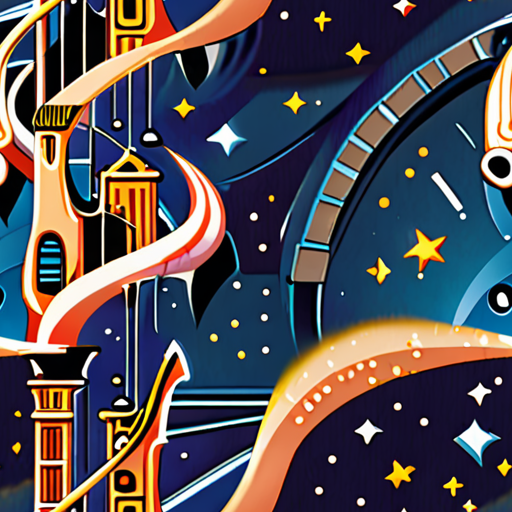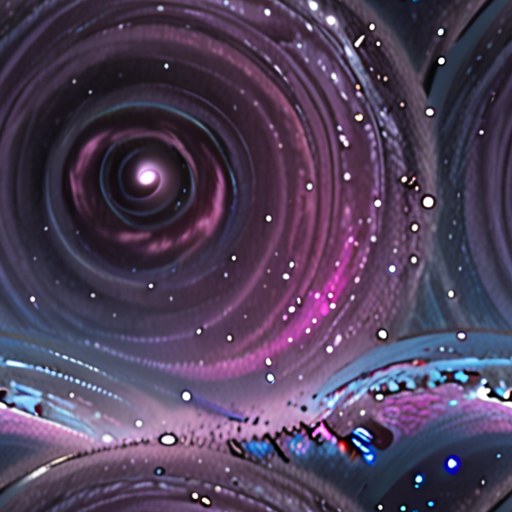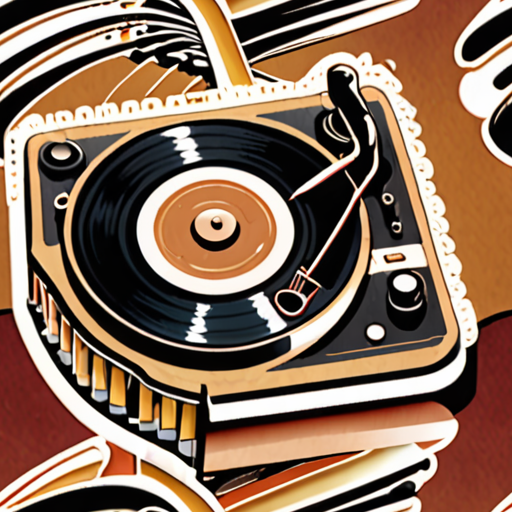As we delve into the captivating realm of jazz fusion, it becomes evident that its evolution has been intricately woven with the visual storytelling of album art. From the psychedelic landscapes of the 1960s to the sleek, modern designs of today, the artwork accompanying these albums has played a pivotal role in shaping the genre’s identity and aesthetic. With its unique blend of styles, jazz fusion has given rise to some of the most iconic and enduring album covers in music history, each one telling a story of innovation, experimentation, and artistic expression.

The Fusion Style of Jazz
Jazz fusion is a genre of music that combines elements of jazz with those of rock, funk, R&B, hip-hop, or electronic music.
- Fusion genres emerged in the late 1960s and early 1970s, and have remained a part of the contemporary jazz scene.
- Jazz fusion often pushes boundaries in instrumentation, incorporating a wide range of instruments and sounds.
- This genre has been influenced by various styles, including free jazz, avant-garde, and experimental music.
- Jazz fusion has also been shaped by the contributions of musicians from diverse backgrounds, including African American, Latinx, and Asian American artists.
Characteristics of Jazz Fusion
Jazz fusion is characterized by its blend of complex harmonies, syncopated rhythms, and improvisational solos.
- Complex chord progressions and extended harmonies are common in jazz fusion music.
- Synthesizers, keyboards, and electronic drum kits are often used to create unique textures and timbres.
- Improvisation plays a crucial role in jazz fusion, allowing musicians to express themselves freely and spontaneously.
- Jazz fusion often incorporates elements of rock, funk, and R&B, making it a dynamic and eclectic genre.
Notable Artists and Bands
Jazz fusion has produced many notable artists and bands, including:
- Miles Davis – A legendary trumpeter and bandleader who was instrumental in shaping the sound of jazz fusion.
- Herbie Hancock – A pianist and composer who has been a major force in jazz fusion since the 1970s.
- Weather Report – A band known for their innovative use of synthesizers and electronic percussion.
- Tony Williams Lifetime – A group led by drummer Tony Williams, which explored the intersection of jazz and rock.
Influence and Legacy
Jazz fusion has had a profound influence on popular music, inspiring countless artists and genres.
- Jazz fusion paved the way for the development of acid jazz, nu-jazz, and other subgenres.
- The genre’s emphasis on experimentation and innovation has inspired musicians across a range of styles.
- Jazz fusion continues to evolve, incorporating new technologies and musical influences.
- Its legacy can be heard in the work of contemporary musicians, from Kendrick Lamar to Kamasi Washington.
What’s the Most Iconic Album Cover of All Time?
The world of music has been blessed with countless incredible album covers, each telling a story and capturing the essence of its respective genre.
- The Velvet Underground & Nico – The Velvet Underground & Nico
- Pink Floyd – Dark Side of the Moon
- The Beatles – Sgt. Pepper’s Lonely Hearts Club Band
- David Bowie – Aladdin Sane
- Jimi Hendrix Experience – Are You Experienced?
- The Rolling Stones – Beggars Banquet
- Michael Jackson – Thriller
- Nirvana – Nevermind
- The Clash – London Calling
- Radiohead – OK Computer
- Kraftwerk – The Man-Machine
- Talking Heads – Remain in Light
- Prince – Purple Rain
- The Smiths – Meat is Murder
- R.E.M. – Murmur
- Depeche Mode – Music for the Masses
- The Cure – Disintegration
- Sonic Youth – Daydream Nation
- My Bloody Valentine – Loveless
- Portishead – Dummy
- Bjork – Homogenic
- Arctic Monkeys – Whatever People Say I Am, That’s What I’m Not
- Kendrick Lamar – Good Kid, M.A.A.D City
- Fleet Foxes – Helplessness Blues
- Tame Impala – Currents
- Vampire Weekend – Modern Vampires of the City
- Daft Punk – Random Access Memories
- The National – High Violet
- TV on the Radio – Desperate Youth, Blood Thirsty Babes
- Beach House – Teen Dream
- CHVRCHES – The Bones of What You Believe
- St. Vincent – St. Vincent
- Lykke Li – Wounded Rhymes
- Grimes – Visions
- M83 – Oblivion
- Arcade Fire – Reflektor
- Pharrell Williams – G I R L
- Oneohtrix Point Never – Replica
- James Blake – Overgrown
- Four Tet – New Energy
- Caribou – Our Love
- Unknown Mortal Orchestra – Multi-Love
- Sharon Van Etten – Are We There
This 1967 debut album features a banana peel on its cover, which has become an iconic symbol of the band’s experimental sound and Andy Warhol’s artistic influence.
Designed by Hipgnosis, the album’s cover features a prism, representing the band’s exploration of light and darkness.
This groundbreaking album’s cover, created by Peter Blake and Jann Haworth, features a colorful array of flowers, celebrities, and musicians, reflecting the band’s innovative spirit.
The cover art, designed by Brian Duffy, showcases Bowie’s bold androgynous look, solidifying his status as a fashion icon.
The psychedelic artwork, created by Eric Hill, captures the essence of Hendrix’s unique blend of rock and psychedelia.
Designed by Andy Warhol, the album’s cover features a wine bottle and label, paying homage to the band’s blues roots.
The cover art, created by Frank DiLeo, features a haunting image of Jackson as a zombie, cementing the album’s status as a pop culture phenomenon.
The iconic baby swimming towards a dollar bill, designed by Robert Fisher, represents the album’s themes of rebellion and social commentary.
The cover art, created by Ray Lowry, features a photograph of a nuclear explosion, reflecting the band’s punk-infused commentary on politics and society.
The cover design, created by Stanley Donwood, features a surreal landscape, echoing the album’s themes of technology-induced alienation.
The cover art, designed by Rolf Borcherding, showcases the band’s futuristic aesthetic, blending electronic music with visual art.
The cover design, created by Alex Steinweiss, features a photograph of the band members, reflecting their eclectic blend of art rock and Afrobeat influences.
The cover art, designed by Prince himself, features a striking image of the musician, showcasing his androgynous style and musical genius.
The cover design, created by Morrissey and Johnny Marr, features a photograph of a pig, reflecting the band’s witty and poetic songwriting style.
The cover art, designed by Chris Bilheimer, features a photograph of the band members, capturing their enigmatic and introspective sound.
The cover design, created by Anton Corbijn, features a striking image of the band members, reflecting their dark and moody soundscapes.
The cover art, designed by Vaughn Oliver, features a haunting image of the band members, capturing their gothic and atmospheric sound.
The cover design, created by Kim Gordon, features a striking image of the band members, reflecting their experimental and noise-rock sound.
The cover art, designed by Vaughan Oliver, features a dreamy and ethereal image, capturing the band’s swirling soundscapes and shoegaze aesthetic.
The cover design, created by Julian House, features a haunting image of the band members, reflecting their trip-hop sound and cinematic atmosphere.
The cover art, designed by Inez & Vinoodh, features a striking image of Bjork, capturing her unique vocal style and eclectic sound.
The cover design, created by Ben Drury, features a photograph of the band members, reflecting their witty and observational songwriting style.
The cover art, designed by Kendrick Lamar and Dave Free, features a striking image of the rapper, capturing his storytelling ability and socially conscious lyrics.
The cover design, created by Sean Pecknold, features a haunting image of the band members, reflecting their harmony-rich sound and pastoral aesthetic.
The cover art, designed by Kevin Parker, features a striking image of the musician, capturing his psychedelic sound and introspective lyrics.
The cover design, created by Ezra Koenig, features a photograph of the band members, reflecting their preppy and indie-rock sound.
The cover art, designed by Daft Punk, features a striking image of the duo, capturing their futuristic and synth-heavy sound.
The cover design, created by Aaron Ross, features a haunting image of the band members, reflecting their brooding and atmospheric sound.
The cover art, designed by TV on the Radio, features a striking image of the band members, capturing their art-rock sound and energetic live performances.
The cover design, created by Beach House, features a haunting image of the band members, reflecting their dream-pop sound and ethereal atmosphere.
The cover art, designed by CHVRCHES, features a striking image of the band members, capturing their synth-pop sound and catchy hooks.
The cover design, created by Annie Clark, features a striking image of the musician, reflecting her eclectic and avant-garde sound.
The cover art, designed by Lykke Li, features a haunting image of the singer-songwriter, capturing her moody and atmospheric sound.
The cover design, created by Grimes, features a striking image of the musician, reflecting her experimental and electronic sound.
The cover art, designed by M83, features a haunting image of the band members, capturing their sweeping and cinematic soundscapes.
The cover design, created by Arcade Fire, features a striking image of the band members, reflecting their anthemic and indie-rock sound.
The cover art, designed by Pharrell Williams, features a striking image of the musician, capturing his funky and upbeat sound.
The cover design, created by Oneohtrix Point Never, features a haunting image of the musician, reflecting his experimental and electronic sound.
The cover art, designed by James Blake, features a striking image of the musician, capturing his emotive and introspective sound.
The cover design, created by Four Tet, features a haunting image of the musician, reflecting his electronic and ambient sound.
The cover art, designed by Caribou, features a striking image of the musician, capturing his eclectic and danceable sound.
The cover design, created by Unknown Mortal Orchestra, features a haunting image of the band members, reflecting their psychedelic and garage-rock sound.
The cover art,

Landmark Album in Jazz Fusion History
In the realm of jazz fusion, there exists a pivotal moment that forever changed the landscape of music.
- Bitches Brew
- Released in 1970 by trumpeter Miles Davis, this groundbreaking album seamlessly merged jazz, rock, and other elements, giving birth to the genre-defining sound of fusion.
- However, the story of jazz fusion predates Bitches Brew, with pioneering artists like Gary Burton, Larry Coryell, and Steve Marcus laying the groundwork for this innovative movement.
Tiger Funk celebrates the rich history and cultural significance of funk, soul, and jazz fusion music through in-depth articles, artist profiles, album reviews, and historical retrospectives.
Other notable albums that contributed to the development of jazz fusion include:
- The Doors – L.A. Woman
- This iconic album, released in 1971, showcased the band’s ability to blend psychedelic rock with jazz and blues elements, further expanding the boundaries of fusion.
- Return to Forever – Hymn of the Seventh Galaxy
- This 1973 album, featuring Chick Corea, Al Di Meola, and Stanley Clarke, exemplified the genre’s potential for intricate instrumental arrangements and virtuosic performances.
As we delve deeper into the world of jazz fusion, it becomes evident that the genre’s evolution is a testament to the creativity and innovation of its pioneers.
At Tiger Funk, we strive to provide a comprehensive resource for fans and enthusiasts, highlighting the impact of funk, soul, and jazz fusion on modern music.
Explore our website to discover more about the fascinating history and diverse sounds of jazz fusion.

Who Dominated Jazz Fusion?
Miles Davis, the legendary trumpeter, was at the forefront of fusing jazz, rock, and funk.
- His pioneering albums In A Silent Way and Bitches Brew featured electric instruments and rock rhythms anchored by jazz improvisation
- Davis’ fusion experiments laid the groundwork for countless others
Main Pioneers of Jazz Fusion
Some notable pioneers of jazz fusion include:
- Miles Davis
- Herbie Hancock
- Weather Report
- The Mahavishnu Orchestra
Other Notable Artists
Other artists who made significant contributions to jazz fusion include:
- Tony Williams Lifetime
- Return to Forever
- Pat Metheny Group
- Chick Corea Elektric Band
Influence on Modern Music
Jazz fusion has had a lasting influence on modern music, with many contemporary artists drawing inspiration from its unique blend of styles.
From electronic and hip-hop to rock and pop, jazz fusion’s innovative spirit continues to shape the sound of popular music today.
The Godfather of Jazz Fusion
Larry Coryell is often referred to as the Godfather of Fusion due to his significant contributions to the genre.
- Coryell’s unique blend of jazz and rock influences helped shape the sound of jazz fusion in the 1960s and 1970s.
- He collaborated with renowned musicians such as Miles Davis, Chet Baker, Charles Mingus, and John McLaughlin, further solidifying his reputation as a pioneer in the field.
- Coryell’s work with the Free Spirits and the Vanguard Jazz Orchestra showcased his ability to seamlessly integrate jazz and rock elements into his music.
- His influence can still be heard in contemporary jazz fusion artists, making him a lasting figure in the genre.
Tiger Funk celebrates the rich history and cultural significance of funk, soul, and jazz fusion music through in-depth articles, artist profiles, and album reviews.
For more information on Larry Coryell and the evolution of jazz fusion, visit our website at Tiger Funk .
Other notable figures in jazz fusion include Herbie Hancock and Weather Report, who have also made significant contributions to the genre.
Learn more about the history and impact of jazz fusion on modern music by exploring our website and discovering the diverse range of artists and styles that have shaped this vibrant genre.

Is Steely Dan Jazz Fusion?
We’ve often heard Steely Dan described as a jazz-rock fusion band, but what does that really mean? To understand whether Steely Dan fits into the jazz fusion genre, let’s dive deeper into the characteristics of jazz fusion and how Steely Dan’s music aligns with those traits.
- Jazz fusion emerged in the late 1960s and early 1970s as a blend of jazz, rock, and funk music.
- This genre was characterized by its use of electronic instruments, complex rhythms, and extended musical forms.
- Jazz fusion drew inspiration from various styles, including free jazz, avant-garde, and classical music.
Steely Dan’s music shares many similarities with jazz fusion. Their sound combines elements of jazz, rock, and pop, featuring intricate instrumental arrangements and sophisticated harmonies.
- Steely Dan’s guitarist, Walter Becker, was heavily influenced by jazz musicians such as Miles Davis and John Coltrane.
- The band’s keyboardist, Donald Fagen, was known for his complex piano compositions and jazz-inspired melodies.
- Steely Dan’s music often featured extended instrumental passages and improvisational sections, characteristic of jazz fusion.
While Steely Dan’s music may not fit neatly into the traditional jazz fusion mold, it certainly draws from the genre’s influences and aesthetic. By incorporating elements of jazz, rock, and pop, Steely Dan created a unique sound that resonated with audiences and helped shape the course of popular music.
Conclusion:
In conclusion, Steely Dan can indeed be classified as a jazz fusion band due to their incorporation of jazz elements, complex instrumentation, and sophisticated harmonies. While their music may not conform to traditional notions of jazz fusion, it undoubtedly reflects the genre’s influence and spirit.

0 Comments